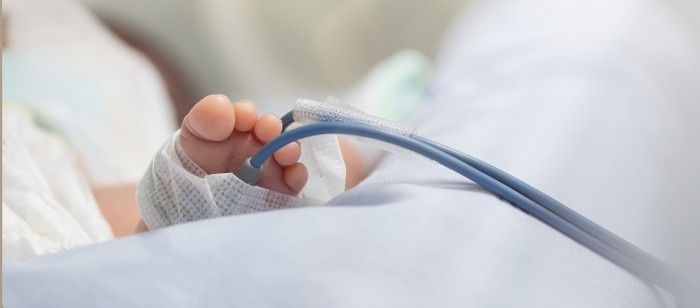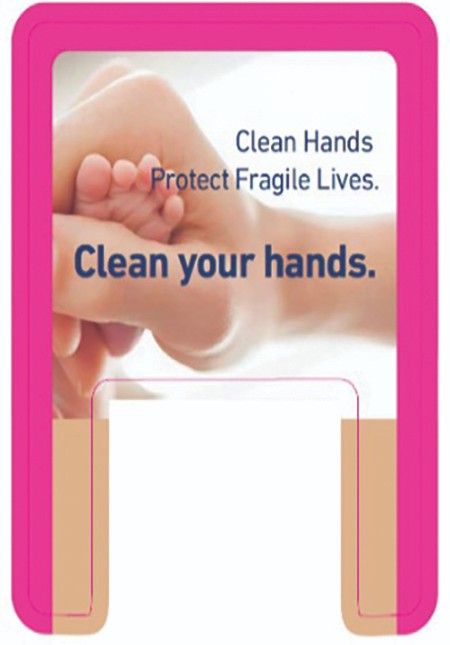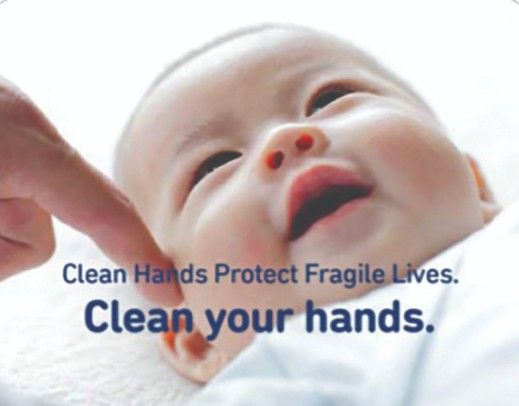Big Germs, Little Lives: Improving Hand Hygiene Through Behavior Modification in the NICU
Using behavior modification to keep the hospitals' tiniest patients safer.
A picture of infant's foot covered with wires. (Adobe Stock)

In a world where electronic hand hygiene monitoring has become the hot topic, what do you do when you either don’t have the system or have a facility that doesn’t have the capability for the system? This is where creativity kicks in, and hand hygiene adherence can become fun. Welcome to the world of behavioral science, where you will learn how to trick the minds of your teammates to increase adherence to hand hygiene through color, images, and a sense of ownership.
Recently, the neonatal intensive care unit (NICU) at Emory University Hospital Midtown in Atlanta, Georgia, was unable to install the hand hygiene electronic monitoring system the rest of the facility was moving to. Thus, the infection prevention, quality, and nursing teams started brainstorming ideas for improving dispenser placement, monitoring, visual aids, and availability of products. With a mixture of room layouts, this made the project difficult at times because some areas had open bays, some had a variety of wall spaces, and some had curtains. The teams realized this problem would not have a singular solution.
The unit team members had been monitoring hand hygiene themselves for years, which was yielding high adherence results and led them to believe there were no improvement opportunities. Although common for manual, unit-based observation programs, this belief often led to falsely high adherence numbers and low yield in terms of understanding where to focus improvement efforts. The infection prevention and quality teams sent in secret shoppers to collect observations, and the results were significantly lower than the self-observations. The teams set out to form a new plan for monitoring and increasing hand hygiene adherence in regard to the hospital’s tiniest patients.
The project team started with a “spaghetti diagram” exercise, where the movement of team members was studied and recorded to understand where the most-used dispensers were located and where additional dispensers were needed. A spaghetti diagram is easy to do, but it does take time—a team member should stand in 1 location and observe movement, drawing a line as they watch another team member “move” around the unit during their normal day-to-day activities. The project team obtained the unit drawings from the facilities management team (FMT) to trace the movements for accuracy of the analysis afterward. Each unique layout of the NICU space was studied in the same way and discussed by the team. Next, the team included the FMT to standardize where the dispensers, paper towels, and sharps containers would be located in every patient space. This standardized placement helped the clinical team create muscle memory to increase adherence when in each space, so they weren’t searching for the hand hygiene products. Partnering with the FMT and environmental services while rounding for this portion of the project was very important, and a great tip for success during rounds in general.
Contagious: Why Things Catch On by Jonah Berger

The idea of applying findings from behavioral science is not new; however, it is not used openly nearly as often as it should be. This strategy is a psychological approach to changing behavior to gain adherence in any type of project or process. The idea originally came from an Association for Professionals in Infection Control and Epidemiology presentation observed many years ago by the project team members, which demonstrated the science behind the use of colors in company logo design and which the members found intriguing. When considering the use of color in fliers, education, and bulletin boards in health care, the team considered how they could use these concepts in their own hand hygiene campaign to draw attention to the hand hygiene dispensers and drive compliance. After reading the book Drunk Tank Pink by Adam Alter, the infection prevention professionals began talking more about using these strategies of color, words, images, and other mechanisms to appeal to individuals’ emotions and senses.
Drunk Tank Pink: And Other Unexpected Forces that Shape How We Think, Feel, and Behave by Adam Alter

The project team talked with the NICU nursing team about adding visual management “placards” above the hand hygiene dispensers that would prompt them to cleanse their hands. The project team showed some examples being used throughout the health care system, and the comments were surprising—the NICU team felt that they were commonly put under the adult population umbrella for education, campaigns, and other marketing plans. They wanted to be seen as an area that had specific and different needs, patients, and opportunities.
An example of what the team created. (Credit: Author)

Hearing this, the project team did 2 things:
1. They worked with their own marketing department to find a diverse set of neonatal images to use on the visual management placards that would speak to the NICU team members more than adult-centered campaign materials would.
2.They created a survey for the NICU team to come up with and vote on a campaign slogan. This allowed the team to feel connected and have a sense of ownership because they had created the slogan and it was theirs alone. This was a strategy the project team learned from the book,
Contagious, by Jonah Berger, about making your ideas go “viral.” By coming up with ideas that other teammates want to talk about, a concept he called “social currency,” you can spread an idea without creating additional education resources.
After visual management placards were placed on all hand gel and soap dispensers throughout the NICU, secret observers measured adherence over a 4-week period. Adherence increased significantly, although not as much as the team would have liked to have seen. Therefore, they set to work brainstorming additional ideas to further provide the NICU team with additional options for behavioral modification techniques to encourage them to clean their hands.
The next phase of the project included “point-of-use” items placed throughout the department. These items consisted of various pump bottles and additional products that could be used to cleanse hands. Another round of observations was completed by the secret shopper team to monitor the effectiveness of these products; however, there was no significant difference in overall hand hygiene adherence although the products were used in the various department areas.
Another example of sign that the team created. (Credit: Author)

The project team decided to focus on the use of color and the emotions that are connected to color. They sent out a survey to all the NICU team members asking them to associate a specific word with various colors. This idea was adapted from a study by Jonauskaite et al.1 The team took the 4 colors that most related to the emotions of happiness and joy and outlined the current placards with this color and had the back of placards be the same solid color. These placards will replace the current placards throughout the department and will be switched out/replaced to rotate the colors on a regular basis. This intervention is planned to go live in the latter part of 2022, with an additional round of adherence observations by the project team.
This hand hygiene project taught the project team to push the limits of creativity and to tailor to the department and the NICU team’s needs. Feeling a sense of ownership for this unique area was important to the NICU team, and the team members appreciated the attention to detail and helped with buy-in to the overall process. Quality improvement projects are not always straightforward and sometimes require infection preventionists to think outside of the box in ways that are uncomfortable. This project also showed hand hygiene adherence improvement from the beginning, although full implementation was delayed due to the COVID-19 pandemic. In addition, the project helped generate new ideas as it progressed and the longer the project team had to get to know the NICU clinical team.
REFERENCE
Jonauskaite D, Abu-Akel A, Dael N, et al. Universal Patterns in Color-Emotion Associations Are Further Shaped by Linguistic and Geographic Proximity. Psychol Sci. 2020;31(10):1245-1260. doi:10.1177/0956797620948810

Phage Therapy’s Future: Tackling Antimicrobial Resistance With Precision Viruses
April 24th 2025Bacteriophage therapy presents a promising alternative to antibiotics, especially as antimicrobial resistance continues to increase. Dr. Ran Nir-Paz discusses its potential, challenges, and future applications in this technology.
Robust infectious disease surveillance, including rapid subtyping of influenza A, is essential for early detection, containment, and public health reporting of novel viral threats.
